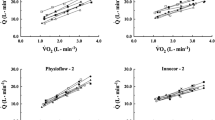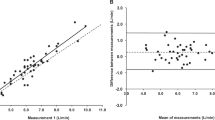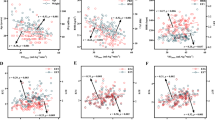Abstract
Bioreactance is a novel non-invasive method for cardiac output measurement that involves the analysis of blood flow-dependent changes in the phase shifts of electrical currents applied across the chest. The present study (1) compared resting and exercise cardiac outputs determined by bioreactance and bioimpedance methods and those estimated from measured oxygen consumption, (2) determined the relationship between cardiac output and oxygen consumption, and (3) assessed the agreement between the bioreactance and bioimpedance methods. Twelve healthy subjects (aged 30 ± 4 years) performed graded cardiopulmonary exercise test on a recumbent cycle ergometer on two occasions, 1 week apart. Cardiac output was monitored at rest, at 30, 50, 70, 90, 150 W and at peak exercise intensity by bioreactance and bioimpedance and expired gases collected. Resting cardiac output was not significantly different between the bioreactance and bioimpedance methods (6.2 ± 1.4 vs. 6.5 ± 1.4 l min−1, P = 0.42). During exercise cardiac outputs were correlated with oxygen uptake for both bioreactance (r = 0.84, P < 0.01) and bioimpedance techniques (r = 0.82, P < 0.01). At peak exercise bioimpedance estimated significantly lower cardiac outputs than both bioreactance and theoretically calculated cardiac output (14.3 ± 2.6 vs. 17.5 ± 5.2 vs. 16.9 ± 4.9 l min−1, P < 0.05). Bland–Altman analyses including data from rest and exercise demonstrated that the bioimpedance method reported ~1.5 l min−1 lower cardiac output than bioreactance with lower and upper limits of agreement of −2.98 to 5.98 l min−1. Bioimpedance and bioreactance methods provide different cardiac output estimates, particularly at high exercise intensity, and therefore the two methods cannot be used interchangeably. In contrast with bioimpedance, bioreactance cardiac outputs are similar to those estimated from measured oxygen consumption.



Similar content being viewed by others
References
Mezzani A, Agostoni P, Cohen-Solal A, Corra U, Jegier A, Kouidi E, et al. Standards for the use of cardiopulmonary exercise testing for the functional evaluation of cardiac patients: a report from the Exercise Physiology Section of the European Association for Cardiovascular Prevention and Rehabilitation. Eur J Cardiovasc Prev Rehabil. 2009;16:249–67.
Warburton DE, Haykowsky MJ, Quinney HA, Humen DP, Teo KK. Reliability and validity of measures of cardiac output during incremental to maximal aerobic exercise. Part I: conventional techniques. Sports Med. 1999;27:23–41.
Sandham JD, Hull RD, Brant RF, Knox L, Pineo GF, Doig CJ, et al. A randomized, controlled trial of the use of pulmonary–artery catheters in high-risk surgical patients. N Engl J Med. 2003;348:5–14.
Harvey S, Stevens K, Harrison D, Young D, Brampton W, McCabe C, et al. An evaluation of the clinical and cost-effectiveness of pulmonary artery catheters in patient management in intensive care: a systematic review and a randomised controlled trial. Health Technol Assess. 2006;10:iii–iv, ix–xi, 1–133.
Jakovljevic DG, Nunan D, Donovan G, Hodges LD, Sandercock GR, Brodie DA. Comparison of cardiac output determined by different rebreathing methods at rest and at peak exercise. Eur J Appl Physiol. 2008;102:593–9.
Christie J, Sheldahl LM, Tristani FE, Sagar KB, Ptacin MJ, Wann S. Determination of stroke volume and cardiac output during exercise: comparison of two-dimensional and Doppler echocardiography, Fick oximetry, and thermodilution. Circulation. 1987;76:539–47.
Moshkovitz Y, Kaluski E, Milo O, Vered Z, Cotter G. Recent developments in cardiac output determination by bioimpedance: comparison with invasive cardiac output and potential cardiovascular applications. Curr Opin Cardiol. 2004;19:229–37.
Warburton DE, Haykowsky MJ, Quinney HA, Humen DP, Teo KK. Reliability and validity of measures of cardiac output during incremental to maximal aerobic exercise. Part II: novel techniques and new advances. Sports Med. 1999;27:241–60.
Keren H, Burkhoff D, Squara P. Evaluation of a noninvasive continuous cardiac output monitoring system based on thoracic bioreactance. Am J Physiol Heart Circ Physiol. 2007;293:H583–9.
Squara P, Denjean D, Estagnasie P, Brusset A, Dib J, Dubois C. Non-invasive cardiac output monitoring (NICOM): clinical evaluation. Intensive Care Med. 2007;33:1191–4.
Maurer MM, Burkhoff D, Maybaum S, Franco V, Vittorio TJ, Williams P, et al. A multicenter study of noninvasive cardiac output by bioreactance during symptom-limited exercise. J Card Fail. 2009;15:689–99.
Myers J, Gujja P, Suresh N, Burkhoff D. Cardiac output and cardiopulmonary responses to exercise in heart failure: application of a new bio-reactance device. J Card Fail. 2007;13:629–36.
Myers J, Gujja P, Neelagaru S, Hsu L, Vittorio T, Jackson-Nelson T, et al. End-tidal CO2 pressure and cardiac performance during exercise in heart failure. Med Sci Sports Exerc. 2009;41:19–25.
Elliott A, Hull JH, Nunan D, Jakovljevic DG, Brodie D, Ansley L. Application of bioreactance for cardiac output assessment during exercise in healthy individuals. Eur J Appl Physiol. 2010;109:945–51.
Stringer WW, Hansen JE, Wasserman K. Cardiac output estimated nonivasively from oxygen uptake during exercise. J Appl Physiol. 1997;82:908–12.
Fortin J, Habenbacher W, Heller A, Hacker A, Grullenberger R, Innerhofer J, et al. Non-invasive beat-to-beat cardiac output monitoring by an improved method of transthoracic bioimpedance measurement. Comput Biol Med. 2006;36:1185–203.
Beitzke M, Pfister P, Fortin J, Skrabal F. Autonomic dysfunction and hemodynamics in vitamin B12 deficiency. Auton Neurosci. 2002;97:45–54.
Gratze G, Fortin J, Holler A, Grasenick K, Pfurtscheller G, Wach P, et al. A software package for non-invasive, real-time beat-to-beat monitoring of stroke volume, blood pressure, total peripheral resistance and for assessment of autonomic function. Comput Biol Med. 1998;28:121–42.
Kubicek WG, Karnegis JN, Patterson RP, Witsoe DA, Mattson RH. Development and evaluation of an impedance cardiac output system. Aerosp Med. 1966;37:1208–12.
Bland MJ, Altman DG. Statistical methods for assessing agreement between two methods of clinical measurements. Lancet. 1986;1:307–10.
Bloch KE, Russi EW. Comparison of impedance cardiography to invasive techniques for measurement of cardiac output. Am J Cardiol. 1997;79:846.
Jensen L, Yakimets J, Teo KK. A review of impedance cardiography. Heart Lung. 1995;24:183–93.
Conflict of interest
The authors declare no conflict of interest.
Author information
Authors and Affiliations
Corresponding author
Rights and permissions
About this article
Cite this article
Jakovljevic, D.G., Moore, S., Hallsworth, K. et al. Comparison of cardiac output determined by bioimpedance and bioreactance methods at rest and during exercise. J Clin Monit Comput 26, 63–68 (2012). https://doi.org/10.1007/s10877-012-9334-4
Received:
Accepted:
Published:
Issue Date:
DOI: https://doi.org/10.1007/s10877-012-9334-4




